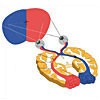
Session Overview
 |
How do we visualize our environment? What problems must the visual system overcome? Upon completion of the session, you will have a better understanding of human perceptual abilities and how the neural substrates of vision are organized in the brain. Keywords: vision, perception, optical illusions, color, light Image by MIT OpenCourseWare. After Figure 10-4b in Bear, Mark F., Barry W. Connors, and Michael A. Paradiso. Neuroscience: Exploring the Brain. 3rd ed. Lippincott Williams & Wilkins, 2007. ISBN: 9780781760034. |
Session Activities
Readings
Read the following before watching the lecture video.
- One of the following textbook chapters:
Lecture Videos
View Full Video
- Lecture 5: Vision I (00:40:59)
View by Chapter
- Introduction to Vision and the Brain (00:03:26)
- Vision as Interpretation (00:05:54)
- Brightness Constancy and Other Illusions (00:08:05)
Brightness Constancy and Other Illusions
> Download from iTunes U (MP4 - 88MB)
> Download from Internet Archive (MP4 - 88MB)
- The Mechanics of Vision: Pre-Visual Cortex (00:05:42)
The Mechanics of Vision: Pre-Visual Cortex
> Download from iTunes U (MP4 - 88MB)
> Download from Internet Archive (MP4 - 88MB)
- The Mechanics of Vision: Visual Cortex (00:07:22)
The Mechanics of Vision: Visual Cortex
> Download from iTunes U (MP4 - 88MB)
> Download from Internet Archive (MP4 - 88MB)
- What and Where Systems (00:06:19)
- Brain Lesions and the Visual System (00:02:56)
Video Resources
Check Yourself
Describe in detail the pathway that transmits visual information from the eye to the primary vision areas in the brain. Also describe the function of each component of the eye when processing visual information.
› View/hide answer
Light enters through the cornea, which begins to focus the light. The light passes through the pupil and through the lens, which focuses the light onto the retina. Retina cells called rods and cones begin to process visual information. Rods respond black, white, and gray colors. Rods do not provide much detail of an image, but respond well in dim light and are important for peripheral vision. Cones respond to color and can detect fine details in an image. Cones respond most to bright light and are mostly located in the center of the retina, called the fovea. Visual information then passes through the bipolar cells to the ganglion cells. From there the visual information is transmitted down the optic nerve to the thalamus, and finally to primary visual cortex in the occipital lobe.
Further Study
These optional resources are provided for students that wish to explore this topic more fully.
| TYPE | CONTENT | CONTEXT |
|---|---|---|
| Website | Schiller Lab | Lab focused on the workings of the visual and oculomotor systems of human and non-human primates. |
| Textbook supplement | Study materials for Chapter 3, "Psychology Sensation and Perception: How the World Enters the Mind," in Study Site for Psychology in Context, 3/e (Pearsonn Education, 2007) | Practice test questions, flashcards, and media for a related textbook by Kosslyn & Rosenberg |
